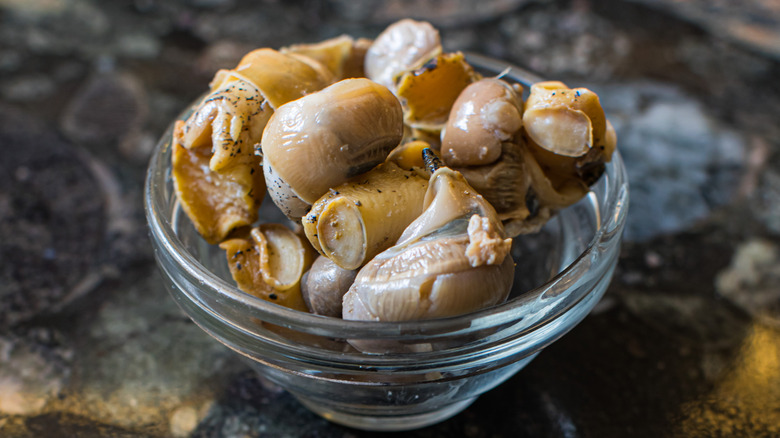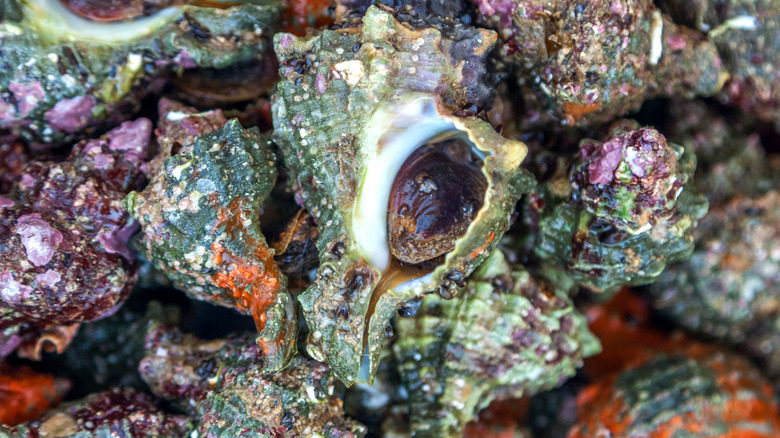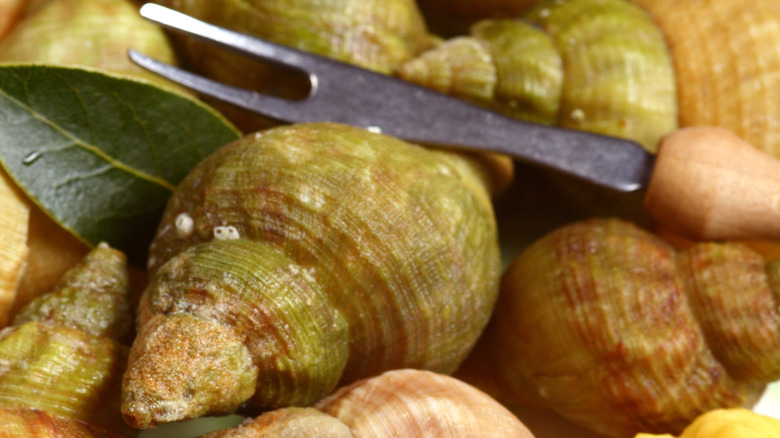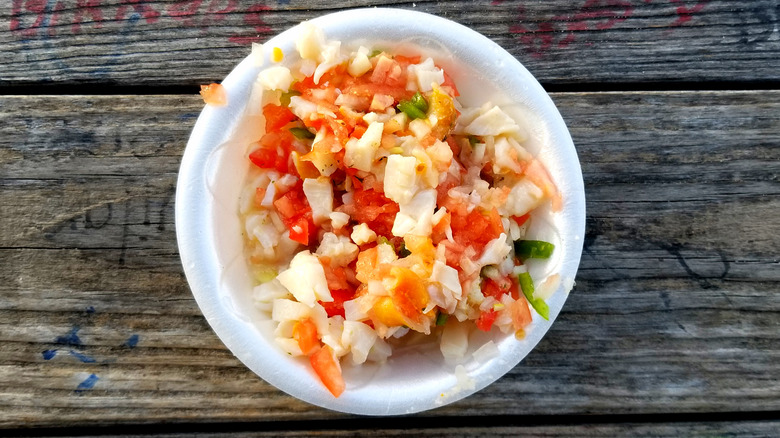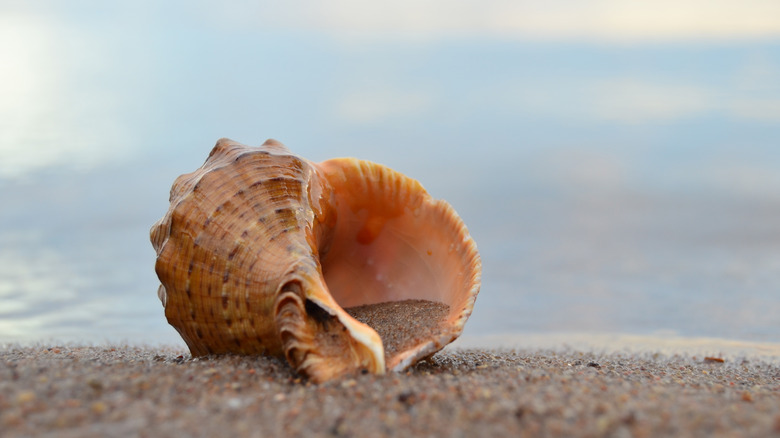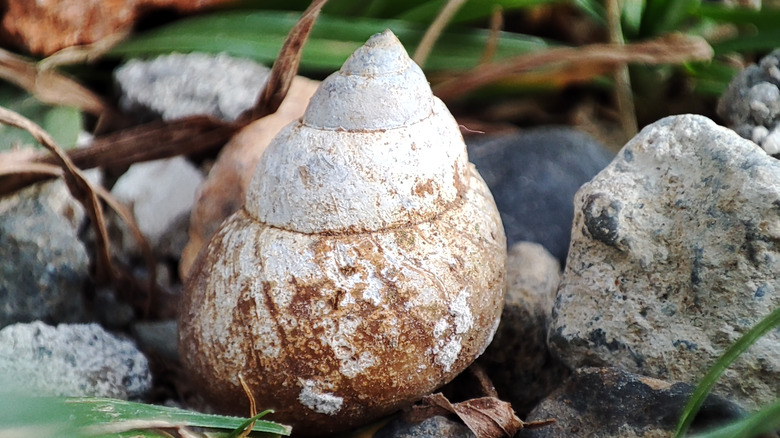What Is Scungilli And What Does It Taste Like?
If you're Italian-American, from the Northeast, or happen to be a big fan of "The Sopranos," you've surely heard the word "scungilli" before — perhaps even pronounced "scoon-jeel." Technically, it's pronounced "scun-GEE-lee" and is usually enjoyed either in a cold seafood salad or stirred into marinara sauces and served over pasta. It's also a mainstay at many Christmas or Christmas Eve Feast of the Seven Fishes dinners, as noted by Edible Jersey.
Still, it's certainly not the most ubiquitous ingredient, and it's far less popular or recognizable than other shellfish or seafood such as calamari, shrimp, or clams. Also, many opt to use canned scungilli, further blurring its potentially unclear origins. So ... what exactly is scungilli? Where does it come from? How is it usually purchased? Is It good for you? Well, no worries! Look no further — we're here to answer all of your pressing questions about scungilli.
What is scungilli?
You've surely heard of and/or seen a conch shell before, right? Well, there you have it! Technically a type of mollusk, scungilli is essentially the "meat" from a conch shell. Basically, it's an oceanic snail of sorts, which is also sometimes called a whelk. According to The Milford Daily News, it can exponentially vary in size. From a linguistics perspective, "scungilli" hails from the Neapolitan dialect and loosely translates to "conch," according to Mangia Bene Pasta.
Scungilli — typically called conch outside of Italian and Italian-American communities — is also incredibly popular throughout the Caribbean, especially in the Bahamas, as excitedly noted in this piece by Bahamas Air Tours. They are a massive part of the lore of the country and are a prized ingredient in varying dishes. In addition, the sea snails are also highly regarded throughout east Asia and are especially popular in Cantonese cuisine.
What does scungilli taste like?
Scungilli is chewy, slightly sweet, and somewhat meaty. While some Italian stores or specialty markets may stock frozen scungilli, most (without immediate access to fresh seafood) simply purchase the conch meat in cans. If overcooked, the meat can be rubbery, but otherwise, it will be dense and flavorful, with a subtle saline flavor reminiscent of the sea, as noted by Citarella. Texturally, it is most similar to calamari, and when cooked properly, it is sensational.
Regardless of how it's purchased, scungilli should also be cleaned and properly prepared prior to eating, which includes removing "tubes" that are primarily inedible. If you have lots of time on your hands, working with fresh scungilli can be a rewarding and fulfilling experience. Nevertheless, many tend to prefer eating or cooking with canned scungilli that has already been fully prepared prior to canning and is essentially ready to eat, according to The Daily Meal. Properly working with fresh scungilli "from scratch" is rather laborious and can be quite challenging — especially for a novice who hasn't worked with conches before.
How to cook with scungilli
Scungilli is incredibly popular and is a refreshing, light treat, often served during the previously mentioned Feast of the Seven Fishes. This sea snail has a distinctive chew and a bit more bite than other seafood fares, which makes it a great fish option. It also holds up to heat and acid very well and can even be breaded and fried, ala calamari. As noted, it can be briny, and that flavor note often plays well with other acidic notes such as lemon or vinegar, along with shallot, garlic, and fresh herbs. As seen in this recipe from Serious Eats, some also stretch the seafood quotient of scungilli salads by adding other kinds like shrimp, octopus, or shellfish; these dishes are usually served chilled. On the other hand, many also cook scungilli and serve it in spicy, hearty dishes, such as fra diavolo.
In addition, many also enjoy conch in stews, soups, or in the vein of a crabcake. In these dishes, chopped scungilli is mixed with bread crumbs, egg, lemon, and other binders before being crisped up in a hot pan. As mentioned before, some also stir it into marinara sauces prior to serving it over steaming hot bowls of pasta (via The Daily Meal).
Beyond Italian-American fare
Bahamian cuisine utilizes conch deep-fried and even raw in salads or as fritters. Raw conch salad is slightly reminiscent of ceviche, the iconic Peruvian dish featuring raw fish "cooked" by citrus juices. In addition to lime, lemon, or other citrus juices, the raw salad is often adorned with various fresh herbs, seasonings, or spices. Furthermore, once the conch meat has been removed, many Bahamians use the shell in jewelry, souvenirs, or other keepsakes. Some even keep the shells whole and use them like a horn (via Bahamas Air Tours).
In 2019, though, National Geographic noted that the conch was endangered due to overfishing, so it's incredibly important that every preservation and conservation effort is made to ensure ample conch/scungilli for years to come. Protecting the conch is an incredibly important initiative, so feel free to do some research into different ways to promote, amplify, and donate to conservation efforts.
Is scungilli good for you?
According to SF Gate, scungilli is high in protein, as well as a good source of folate, vitamin E, iron, potassium, and vitamin B12. A can of conch is also reliably economical, making a scungilli salad or pasta a delicious, healthy, and affordable meal. Furthermore, it's a great source of calcium and also contains both selenium and magnesium.
As Eat Something Sexy notes, some even consider scungilli to be an aphrodisiacal food, so it is also often thought to be an excellent option for a romantic dinner, such as a Valentine's Day meal. VICE notes, though, that this is actually not scientifically proven, but more so something of a myth. Nevertheless, that hasn't stopped the rumor from persisting.
Intrigued? There's no need to wait for Christmas Eve to whip up a healthful seafood salad — scungilli is truly a win-win. Try it out as a new addition to your weeknight meal repertoire, and we bet you'll become a huge fan! We know that we are.
